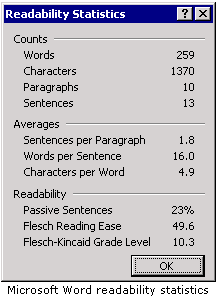Using MS Word Readability Statistics for Web Writing
Microsoft Word's readability scores are based on American audiences and Word's sometimes quirky grammar checking, but they can give an idea of the readability of Web content and provide some general rules of thumb that can be useful.
The Readability Statistics facility in Microsoft Word includes:
- Counts: the number of words, characters, paragraphs, and sentences in the document.
- Averages: average sentences per paragraph, words per sentence, and characters per word.
- Readability statistics: percentage of passive sentences in the document, Flesch Reading Ease score, Flesch-Kincaid Grade Level.
You'll need grammar checking turned on to display readability statistics (even if you turn it off afterwards). To display readability statistics:
- Go to the Tools menu and select Options.
- Click the Spelling & Grammar tab.
- Tick the Check grammar with spelling and Show readability statistics checkboxes.
- Click OK.
- Go to the Tools menu and select Spelling and Grammar (or use the F7 key).
Interpreting Readability Statistics
Some of the information presented by Word's readability statistics is of little use, but you can use some of the statistics to check word count rules of thumb.
For Web writing:
- The total word count (Counts > Words) should be no greater than 500 words for a general page, or 700 words for a long page.
- The average length of sentences (Averages > Words per Sentence) should be no greater than 15 - 20 words.
- The number of words per paragraph ([Averages > Sentence per Paragraph] x [Averages > Words per Sentence]) should be no greater than 40 - 70 words for general prose, or 30 - 50 words for a summary paragraph.

The Readability area can draw attention to possible problems in the general writing style of the document. When...
- the Passive Sentences percentage is higher than 15%, or
- the Flesch Reading Ease score is lower than 60%, or
- the Flesch-Kincaid Grade Level score is greater than 5 - 7 (for younger readers), 5 - 9 (general readers) or 7 - 12 (industry or technical readers)
… you need to look at the document with fresh eyes.
Note that the Flesch-Kincaid Grade Level score needs to be lower for Web content than for hardcopy material, taking the physiological factors (eg. decreased reading speed and comprehension, increased fatigue) into account, as well as the lack of peripheral cues and easy access to related information.
Counting Web Words in Microsoft Word   Australian Spell Checking in MS Word Australian Spell Checking in MS Word
Related:
Counting Words for Web Writing
|